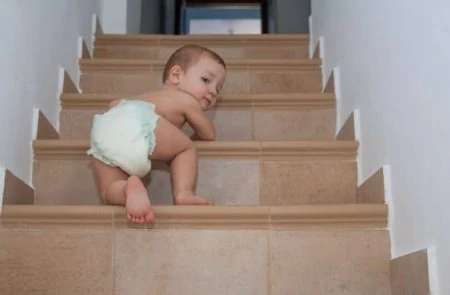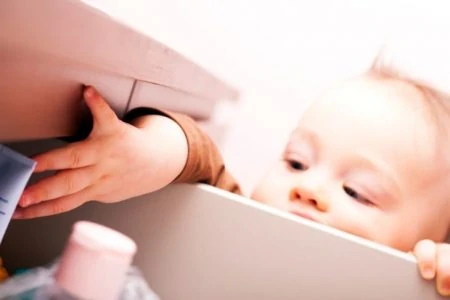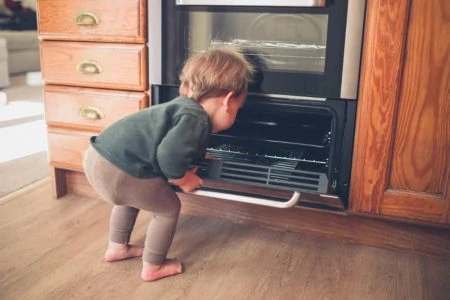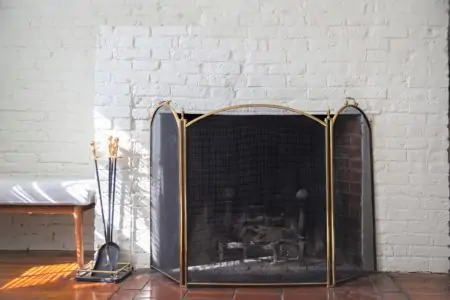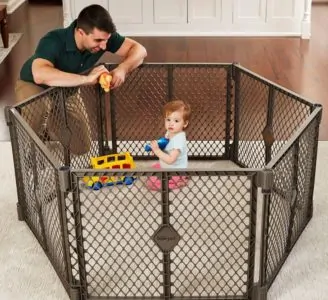Watching your little one eye the staircase is enough to make any parent’s heart skip a beat.
If you haven’t started babyproofing your home yet, the stairs are the absolute best place to begin. The stats are sobering; in the United States, a child is injured on stairs every six minutes (1).
We are here to help you navigate the necessary safety measures to avoid stair-related injuries. We will cover when to start, how to choose the right barriers, and specific installation tips for tricky banisters.
With the right gear and a solid plan, you can keep your home safe for your explorer while keeping the upper levels accessible for you.
Key Takeaways
- Start babyproofing stairs when your baby is around 6 months old or shows signs of crawling.
- Always use hardware-mounted gates at the top of stairs; pressure-mounted gates are safe only for the bottom.
- Check banister gaps; if they are wider than 4 inches, install a guard or netting.
- Remove gates once your child learns to climb over them or reaches 2 years of age.
When To Start Babyproofing Stairs?
In clinical practice, I begin the discussion of “babyproofing” the home at the 6-month-old well visit. I feel that this is a good time to have the discussion because most babies have not yet become self-mobile.In general, infants begin crawling between 6 and 12 months of age. Some can pull themselves to a standing position or take steps while holding onto furniture around the same time. Having an early discussion gives the parent time to prepare and find the best stair protection option.
Editor's Note:
Dr. Leah Alexander, MD, FAAPWhich Stairs Should Be Babyproofed?
Every set of stairs in your home needs protection, regardless of size. While a steep main staircase is the obvious danger zone, even small sets of steps leading to a sunken living room or a basement need barriers.
In some homes, you might have a single step transition between rooms.
The safest approach is to limit access here as well. Place an expandable gate or barrier across that single step. It prevents your new walker from taking a surprising tumble that could result in bumps, bruises, or worse.
How To Babyproof Your Stairs
When it comes to stairwells, the goal is total restriction. You cannot “teach” a baby to be safe on stairs yet, so you must physically block access at both the top and the bottom.
Since babies are determined explorers, proper installation is just as important as the gear you buy.
1. Install Baby Gates
The most effective way to secure stairs is by installing a reliable baby gate. While there are dozens of styles, the placement dictates the type you need. You must block the entry and exit points completely.
2. Anchor the Gates Correctly

Read the manual before you pick up a screwdriver. An improperly installed gate offers a false sense of security and can actually be more dangerous if it collapses under your child’s weight.
Here is the golden rule of stair safety: Never use pressure-mounted gates at the top of the stairs.
Pressure gates can slip if a child pushes against them, sending both the baby and the gate tumbling down. You must use hardware-mounted gates (screwed into the wall or banister) at the top. If you have decorative banisters you do not want to drill into, look for mounting kits or “banister adapters” that clamp onto the wood to provide a safe surface for drilling.
3. Check Stair Maintenance
A physical barrier isn’t the only safety factor. Broken or loose steps can cause adults to trip while carrying a baby.
Inspect your stairs frequently for:
- Loose carpeting or runners that could cause slips.
- Exposed nails or staples.
- Wobbly banisters or railings.
About 25% of stair-related injuries in young children occur while they are being carried by a parent, so your sure-footedness matters just as much as the gate does.
Choosing a Baby Gate
Every staircase is unique. You might have drywall on one side and a wrought-iron railing on the other. Identifying your specific layout is crucial before you shop to avoid frustration and returns.
Walk through your home and visualize the daily flow.
Consider these factors to make the right choice:
- Mounting style: As mentioned, top-of-stairs gates must be hardware-mounted. Bottom-of-stairs gates can be pressure-mounted.
- Opening mechanism: Look for gates you can open with one hand. You will often be carrying a baby or a laundry basket, and a complex two-hand latch will become a nuisance quickly.
- Trip hazards: Many pressure-mounted gates have a bottom bar that runs across the floor. This is a major trip hazard at the top of stairs. Avoid these for upper-level use.
- Traffic flow: In high-traffic areas, a gate that swings shut and auto-locks is a lifesaver. You do not want to accidentally leave the safety barrier open because you were in a rush.
- Width and height: Measure your opening three times: at the top, middle, and bottom. Baseboards can make the bottom narrower than the top. Ensure the gate is tall enough (at least 22 inches is standard) so your toddler cannot flip over it.
3 Great Stair-Proofing Baby Gates
Finding the right gate can feel overwhelming given the sheer number of options on the market. We have categorized three top choices based on where and how they should be used to help you decide.
1. Expandable Baby Gates

Best For: The bottom of the stairs or doorways between rooms.
Expandable gates, often made of wood or plastic mesh, are a classic choice. They adjust to fit various widths and usually rely on pressure mounting or a simple locking bar.
Why we like it: They are generally affordable and easy to move. However, because many are pressure-mounted or have a “step-over” design, they are strictly for the bottom of the stairs. Do not use this style at the top; the risk of slipping or tripping is too high.
2. Multi-Panel Baby Gates

Best For: Wide staircases, open floor plans, or irregular landings.
If your staircase has a wide landing or is located in a spot where a standard door-sized gate won’t fit, multi-panel gates are the solution. These can be configured into odd shapes or extended to span several feet.
Why we like it: Versatility. You can mount the hardware on the walls on either side of the staircase and angle the panels to fit. They also double as excellent play yards or fireplace barriers.
3. Tall Walk-Through Gates

Best For: The top of the stairs (when hardware mounted).
This is the gold standard for stair safety. These gates usually feature a swinging door that allows you to walk through without stepping over a bar (if you choose the right model).
Why we like it: Safety meets convenience. Look for a model that has no bottom threshold bar (to prevent tripping) and includes hardware to screw it into the wall studs. The latch systems are typically toddler-proof but easy for adults to operate.
How To Babyproof Stair Railings
If you have balusters (spindles) on your staircase, you need to check the spacing. If a soda can fits between the spindles (roughly 4 inches), a baby can squeeze their body through, or worse, get their head stuck.
1. Install a Banister Guard

The easiest fix is a banister guard, a sheet of heavy-duty plastic or durable mesh that runs along the railing. While it might not win any interior design awards, it effectively closes off the gaps.
Ensure you install it on the side of the banister that faces the stairs so the baby cannot push it outward.
2. Try a DIY Solution
If you are handy, you can create a custom solution that blends better with your home décor. Some parents use Plexiglas sheets for a modern look or fabric that matches their curtains.
Check out this video for some DIY inspiration:
3. Reevaluate Your Railings
Sometimes the structure itself is the issue. I grew up in a house with a steep basement stairwell that had no railing at all. One slip sent me tumbling until my dad caught me.
If your railing is wobbly, too low, or non-existent, make that repair your priority. Installing a sturdy handrail is a relatively low-cost project that protects both your child and the adults carrying them.
Tips for Safe Stairs
Beyond gates and guards, maintaining a safe environment is key. Your habits play a huge role in preventing accidents.
Here are a few actionable tips to keep your stairwell safe:
1. Declutter Ruthlessly
Stairs are magnets for clutter. It is easy to leave a basket of laundry, a stack of books, or stray toys on the steps “to take up later.”
Resist this urge. A single toy car can act like a roller skate under your foot. Keep the stairs completely clear of objects 100% of the time.
2. Consider Carpeting or Treads
Hardwood stairs are beautiful, but they are slippery, especially in socks. Carpet runners or non-slip adhesive treads add necessary traction.
If full carpeting isn’t in the budget, look for clear anti-slip tape. It is barely visible but provides grip for little feet (and yours).
3. Teach Safe Climbing
Once your child is old enough to navigate stairs (usually around 18 months to 2 years), teach them the safest method: “Tummy time on the stairs.”
Show them how to go down backward, on their belly, feet first. This lowers their center of gravity and significantly reduces the risk of a head-first fall.
4. Know When To Remove Gates
Baby gates are not forever. Once your child attempts to climb over the gate, the gate becomes a hazard itself. Falling from the top of a gate is more dangerous than falling from the bottom step.
Most manufacturers recommend removing gates when the child is 2 years old or can climb over them.
Stair Babyproofing Don’ts
You can buy the best gear in the world, but improper use renders it useless.
Avoid these common mistakes to ensure your safety measures actually work:
1. Don’t Leave Gaps
Gates are not effective if there is space on the sides or bottom. A child can get their head entrapped in gaps between the gate frame and the wall. Follow the manufacturer’s extension guidelines strictly to ensure a tight fit.
2. Don’t Mount High Off the Ground
Never install a gate a few inches off the floor to get extra height. A curious baby will try to crawl underneath and could get stuck or wedge themselves in a way that suffocates them. The gate should be flush with the floor (or as close as the instructions allow).
3. Don’t Stack Gates
It might be tempting to stack two short gates on top of each other to make a “super tall” barrier, or zip-tie two gates side-by-side for a wide opening. Do not do this.
Stacking gates creates instability and dangerous entrapment gaps. If you need a wider or taller gate, buy one specifically designing for those dimensions.
4. Don’t Climb Over the Gate
We are all guilty of this, but try not to step over the baby gate. If you trip, you could fall on your child. Furthermore, toddlers love to imitate their parents. If they see you swinging your leg over the gate, they will try to do the same.
Babyproofing Stairs FAQs
Are Your Stairs Prepared?
Making your stairs off-limits is one of the most effective ways to prevent serious childhood injuries. It gives you peace of mind and keeps your adventurous crawler out of harm’s way.
Remember to prioritize hardware-mounted gates for the top of the stairs and keep the steps free of clutter. With the right setup, you can breathe a little easier knowing your home is secure.
